Organisational Behaviour Report: Analysing BBC's Team Effectiveness
VerifiedAdded on 2020/06/06
|12
|3859
|198
Report
AI Summary
This report delves into the intricacies of organisational behaviour within the British Broadcasting Corporation (BBC). It commences by examining Handy's cultural typology and its implications, followed by an analysis of how culture, power, and politics influence employee behaviour. The report then explores content and process theories of motivation, including Maslow's hierarchy, Herzberg's two-factor theory, reinforcement theory, and expectancy theory, and discusses how these theories, alongside other motivational techniques such as appraisals and rewards, can enhance team effectiveness. Furthermore, the report investigates different team types within the BBC, identifies effective team practices, and suggests organisational concepts to improve team performance and productivity. It concludes by highlighting the main barriers to effective team performance within the BBC. The report provides a comprehensive overview of the key factors affecting employee behaviour and team dynamics within a large media organisation.
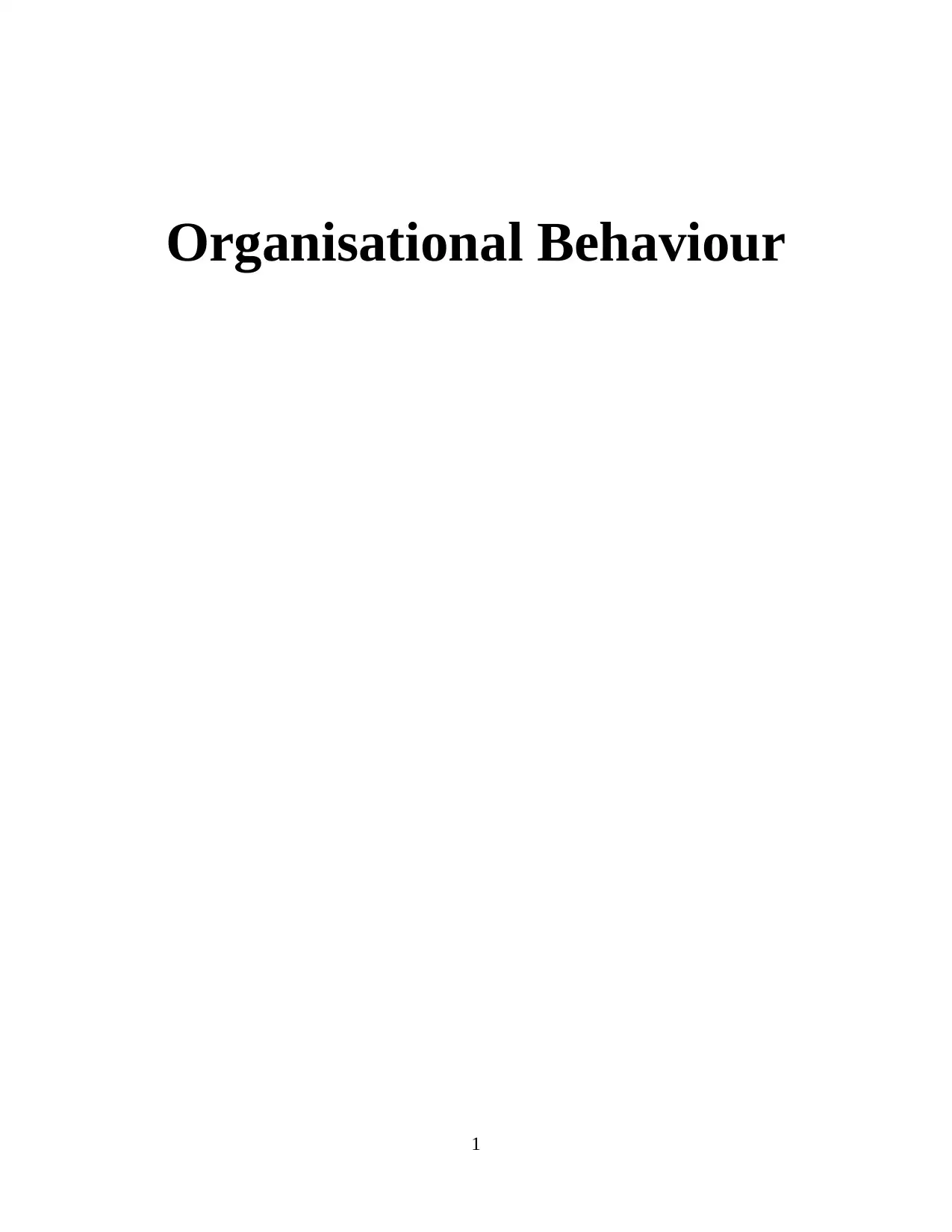
Organisational Behaviour
1
1
Paraphrase This Document
Need a fresh take? Get an instant paraphrase of this document with our AI Paraphraser
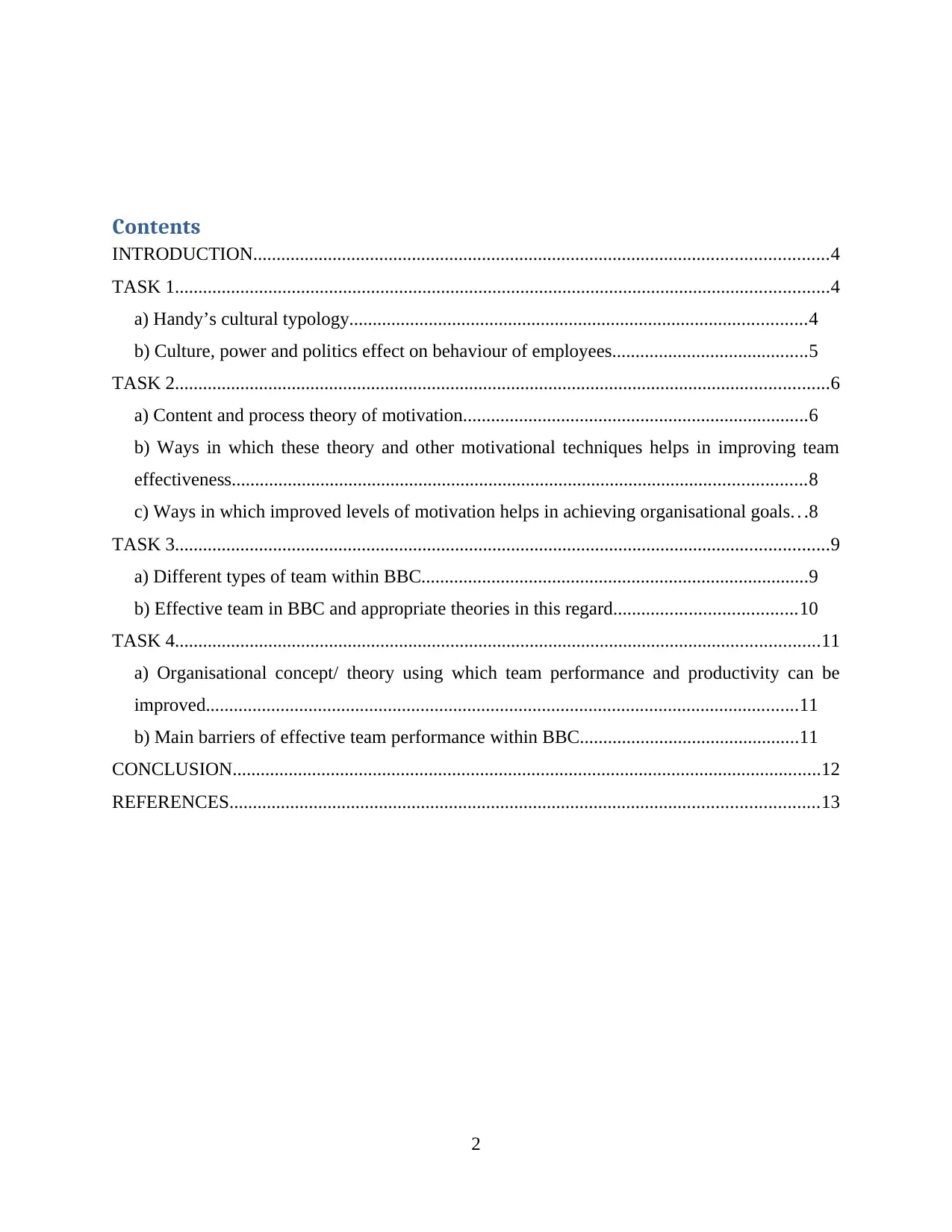
Contents
INTRODUCTION...........................................................................................................................4
TASK 1............................................................................................................................................4
a) Handy’s cultural typology..................................................................................................4
b) Culture, power and politics effect on behaviour of employees..........................................5
TASK 2............................................................................................................................................6
a) Content and process theory of motivation..........................................................................6
b) Ways in which these theory and other motivational techniques helps in improving team
effectiveness...........................................................................................................................8
c) Ways in which improved levels of motivation helps in achieving organisational goals. . .8
TASK 3............................................................................................................................................9
a) Different types of team within BBC...................................................................................9
b) Effective team in BBC and appropriate theories in this regard.......................................10
TASK 4..........................................................................................................................................11
a) Organisational concept/ theory using which team performance and productivity can be
improved...............................................................................................................................11
b) Main barriers of effective team performance within BBC...............................................11
CONCLUSION..............................................................................................................................12
REFERENCES..............................................................................................................................13
2
INTRODUCTION...........................................................................................................................4
TASK 1............................................................................................................................................4
a) Handy’s cultural typology..................................................................................................4
b) Culture, power and politics effect on behaviour of employees..........................................5
TASK 2............................................................................................................................................6
a) Content and process theory of motivation..........................................................................6
b) Ways in which these theory and other motivational techniques helps in improving team
effectiveness...........................................................................................................................8
c) Ways in which improved levels of motivation helps in achieving organisational goals. . .8
TASK 3............................................................................................................................................9
a) Different types of team within BBC...................................................................................9
b) Effective team in BBC and appropriate theories in this regard.......................................10
TASK 4..........................................................................................................................................11
a) Organisational concept/ theory using which team performance and productivity can be
improved...............................................................................................................................11
b) Main barriers of effective team performance within BBC...............................................11
CONCLUSION..............................................................................................................................12
REFERENCES..............................................................................................................................13
2
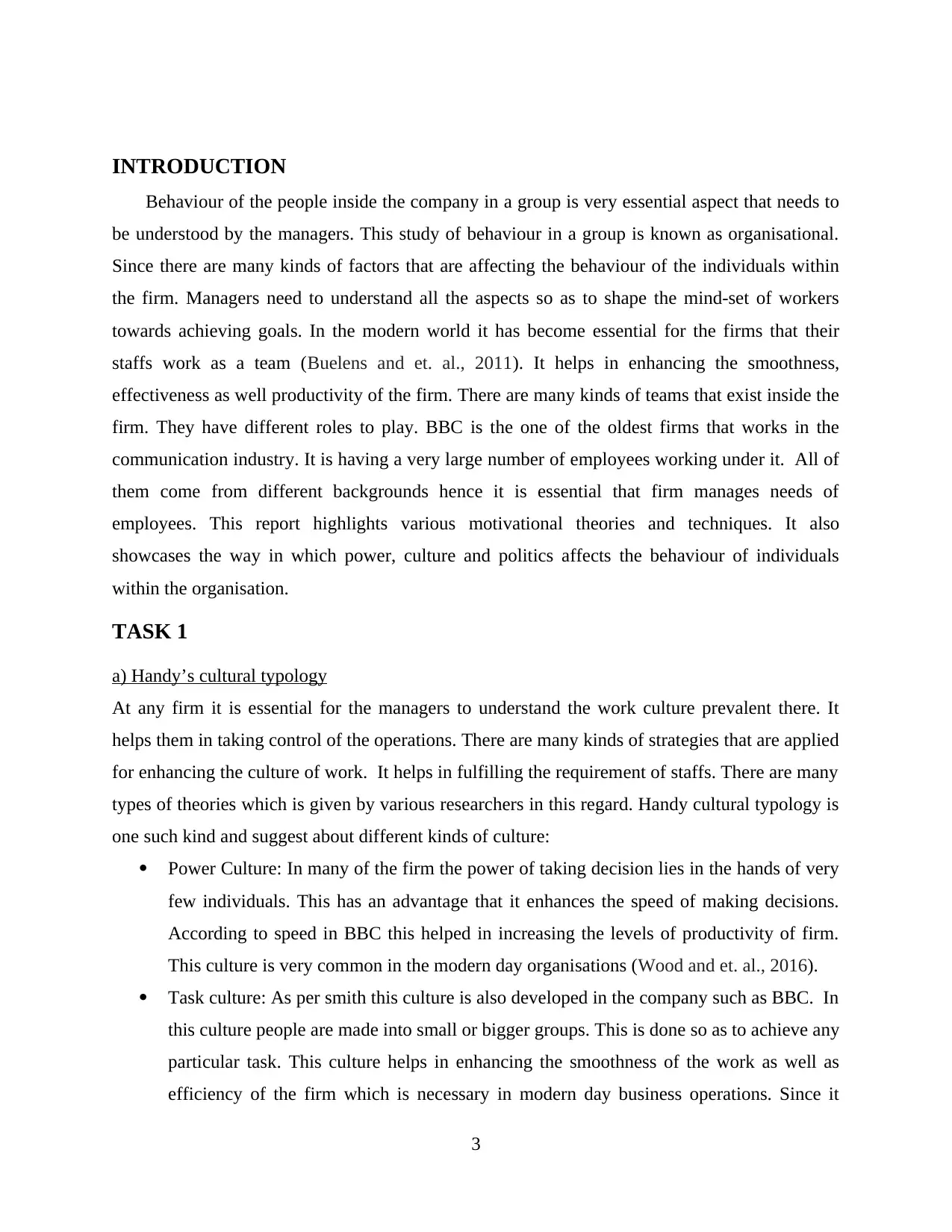
INTRODUCTION
Behaviour of the people inside the company in a group is very essential aspect that needs to
be understood by the managers. This study of behaviour in a group is known as organisational.
Since there are many kinds of factors that are affecting the behaviour of the individuals within
the firm. Managers need to understand all the aspects so as to shape the mind-set of workers
towards achieving goals. In the modern world it has become essential for the firms that their
staffs work as a team (Buelens and et. al., 2011). It helps in enhancing the smoothness,
effectiveness as well productivity of the firm. There are many kinds of teams that exist inside the
firm. They have different roles to play. BBC is the one of the oldest firms that works in the
communication industry. It is having a very large number of employees working under it. All of
them come from different backgrounds hence it is essential that firm manages needs of
employees. This report highlights various motivational theories and techniques. It also
showcases the way in which power, culture and politics affects the behaviour of individuals
within the organisation.
TASK 1
a) Handy’s cultural typology
At any firm it is essential for the managers to understand the work culture prevalent there. It
helps them in taking control of the operations. There are many kinds of strategies that are applied
for enhancing the culture of work. It helps in fulfilling the requirement of staffs. There are many
types of theories which is given by various researchers in this regard. Handy cultural typology is
one such kind and suggest about different kinds of culture:
Power Culture: In many of the firm the power of taking decision lies in the hands of very
few individuals. This has an advantage that it enhances the speed of making decisions.
According to speed in BBC this helped in increasing the levels of productivity of firm.
This culture is very common in the modern day organisations (Wood and et. al., 2016).
Task culture: As per smith this culture is also developed in the company such as BBC. In
this culture people are made into small or bigger groups. This is done so as to achieve any
particular task. This culture helps in enhancing the smoothness of the work as well as
efficiency of the firm which is necessary in modern day business operations. Since it
3
Behaviour of the people inside the company in a group is very essential aspect that needs to
be understood by the managers. This study of behaviour in a group is known as organisational.
Since there are many kinds of factors that are affecting the behaviour of the individuals within
the firm. Managers need to understand all the aspects so as to shape the mind-set of workers
towards achieving goals. In the modern world it has become essential for the firms that their
staffs work as a team (Buelens and et. al., 2011). It helps in enhancing the smoothness,
effectiveness as well productivity of the firm. There are many kinds of teams that exist inside the
firm. They have different roles to play. BBC is the one of the oldest firms that works in the
communication industry. It is having a very large number of employees working under it. All of
them come from different backgrounds hence it is essential that firm manages needs of
employees. This report highlights various motivational theories and techniques. It also
showcases the way in which power, culture and politics affects the behaviour of individuals
within the organisation.
TASK 1
a) Handy’s cultural typology
At any firm it is essential for the managers to understand the work culture prevalent there. It
helps them in taking control of the operations. There are many kinds of strategies that are applied
for enhancing the culture of work. It helps in fulfilling the requirement of staffs. There are many
types of theories which is given by various researchers in this regard. Handy cultural typology is
one such kind and suggest about different kinds of culture:
Power Culture: In many of the firm the power of taking decision lies in the hands of very
few individuals. This has an advantage that it enhances the speed of making decisions.
According to speed in BBC this helped in increasing the levels of productivity of firm.
This culture is very common in the modern day organisations (Wood and et. al., 2016).
Task culture: As per smith this culture is also developed in the company such as BBC. In
this culture people are made into small or bigger groups. This is done so as to achieve any
particular task. This culture helps in enhancing the smoothness of the work as well as
efficiency of the firm which is necessary in modern day business operations. Since it
3
⊘ This is a preview!⊘
Do you want full access?
Subscribe today to unlock all pages.

Trusted by 1+ million students worldwide
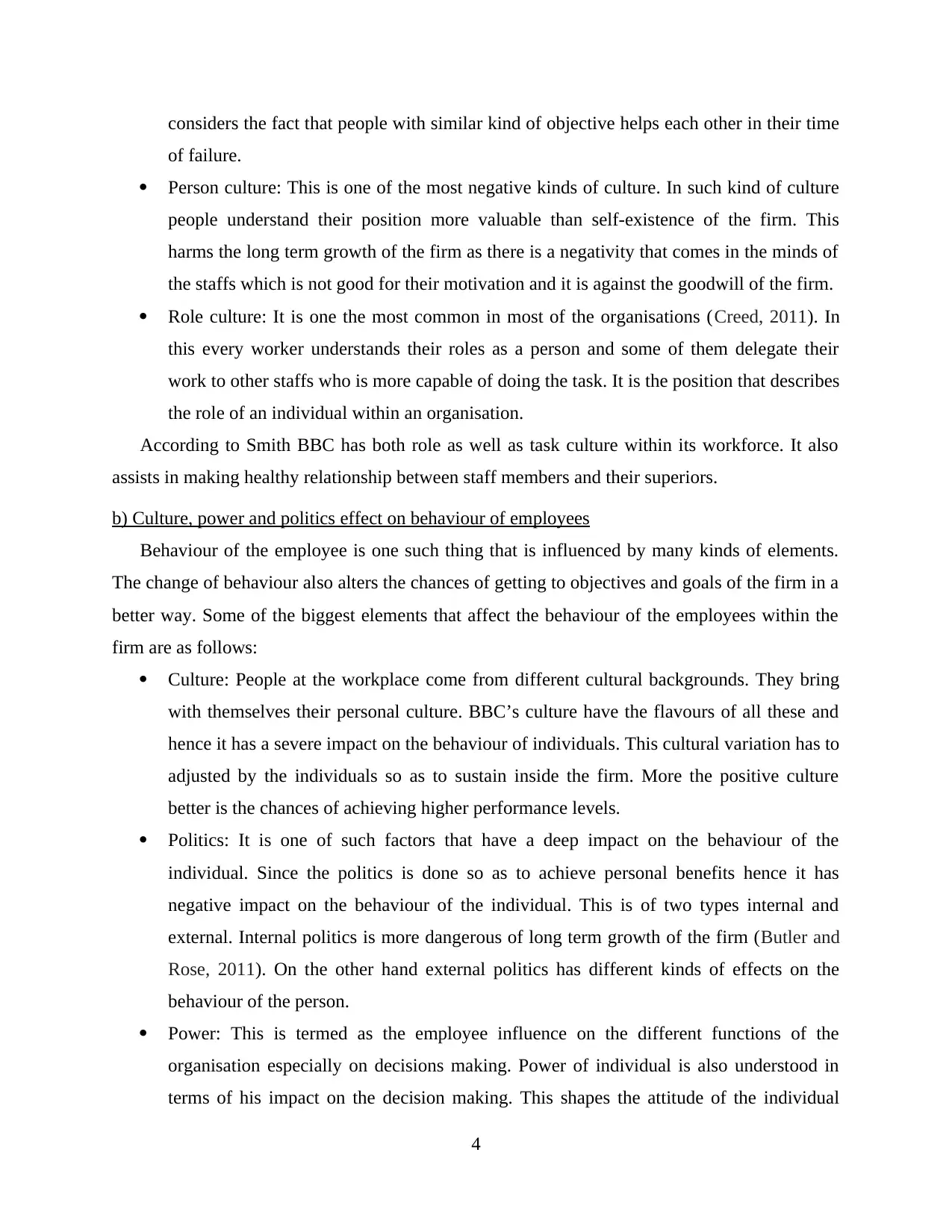
considers the fact that people with similar kind of objective helps each other in their time
of failure.
Person culture: This is one of the most negative kinds of culture. In such kind of culture
people understand their position more valuable than self-existence of the firm. This
harms the long term growth of the firm as there is a negativity that comes in the minds of
the staffs which is not good for their motivation and it is against the goodwill of the firm.
Role culture: It is one the most common in most of the organisations (Creed, 2011). In
this every worker understands their roles as a person and some of them delegate their
work to other staffs who is more capable of doing the task. It is the position that describes
the role of an individual within an organisation.
According to Smith BBC has both role as well as task culture within its workforce. It also
assists in making healthy relationship between staff members and their superiors.
b) Culture, power and politics effect on behaviour of employees
Behaviour of the employee is one such thing that is influenced by many kinds of elements.
The change of behaviour also alters the chances of getting to objectives and goals of the firm in a
better way. Some of the biggest elements that affect the behaviour of the employees within the
firm are as follows:
Culture: People at the workplace come from different cultural backgrounds. They bring
with themselves their personal culture. BBC’s culture have the flavours of all these and
hence it has a severe impact on the behaviour of individuals. This cultural variation has to
adjusted by the individuals so as to sustain inside the firm. More the positive culture
better is the chances of achieving higher performance levels.
Politics: It is one of such factors that have a deep impact on the behaviour of the
individual. Since the politics is done so as to achieve personal benefits hence it has
negative impact on the behaviour of the individual. This is of two types internal and
external. Internal politics is more dangerous of long term growth of the firm (Butler and
Rose, 2011). On the other hand external politics has different kinds of effects on the
behaviour of the person.
Power: This is termed as the employee influence on the different functions of the
organisation especially on decisions making. Power of individual is also understood in
terms of his impact on the decision making. This shapes the attitude of the individual
4
of failure.
Person culture: This is one of the most negative kinds of culture. In such kind of culture
people understand their position more valuable than self-existence of the firm. This
harms the long term growth of the firm as there is a negativity that comes in the minds of
the staffs which is not good for their motivation and it is against the goodwill of the firm.
Role culture: It is one the most common in most of the organisations (Creed, 2011). In
this every worker understands their roles as a person and some of them delegate their
work to other staffs who is more capable of doing the task. It is the position that describes
the role of an individual within an organisation.
According to Smith BBC has both role as well as task culture within its workforce. It also
assists in making healthy relationship between staff members and their superiors.
b) Culture, power and politics effect on behaviour of employees
Behaviour of the employee is one such thing that is influenced by many kinds of elements.
The change of behaviour also alters the chances of getting to objectives and goals of the firm in a
better way. Some of the biggest elements that affect the behaviour of the employees within the
firm are as follows:
Culture: People at the workplace come from different cultural backgrounds. They bring
with themselves their personal culture. BBC’s culture have the flavours of all these and
hence it has a severe impact on the behaviour of individuals. This cultural variation has to
adjusted by the individuals so as to sustain inside the firm. More the positive culture
better is the chances of achieving higher performance levels.
Politics: It is one of such factors that have a deep impact on the behaviour of the
individual. Since the politics is done so as to achieve personal benefits hence it has
negative impact on the behaviour of the individual. This is of two types internal and
external. Internal politics is more dangerous of long term growth of the firm (Butler and
Rose, 2011). On the other hand external politics has different kinds of effects on the
behaviour of the person.
Power: This is termed as the employee influence on the different functions of the
organisation especially on decisions making. Power of individual is also understood in
terms of his impact on the decision making. This shapes the attitude of the individual
4
Paraphrase This Document
Need a fresh take? Get an instant paraphrase of this document with our AI Paraphraser
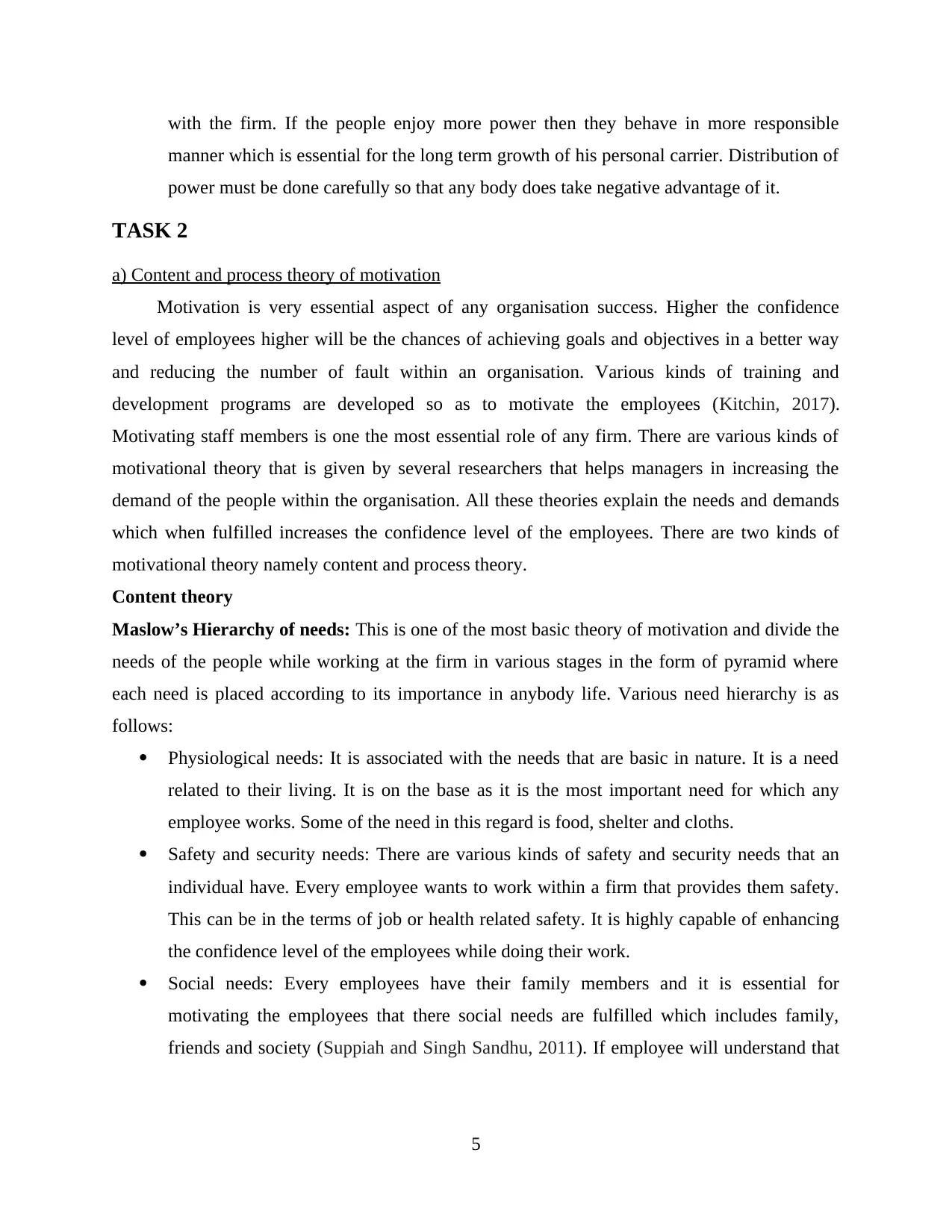
with the firm. If the people enjoy more power then they behave in more responsible
manner which is essential for the long term growth of his personal carrier. Distribution of
power must be done carefully so that any body does take negative advantage of it.
TASK 2
a) Content and process theory of motivation
Motivation is very essential aspect of any organisation success. Higher the confidence
level of employees higher will be the chances of achieving goals and objectives in a better way
and reducing the number of fault within an organisation. Various kinds of training and
development programs are developed so as to motivate the employees (Kitchin, 2017).
Motivating staff members is one the most essential role of any firm. There are various kinds of
motivational theory that is given by several researchers that helps managers in increasing the
demand of the people within the organisation. All these theories explain the needs and demands
which when fulfilled increases the confidence level of the employees. There are two kinds of
motivational theory namely content and process theory.
Content theory
Maslow’s Hierarchy of needs: This is one of the most basic theory of motivation and divide the
needs of the people while working at the firm in various stages in the form of pyramid where
each need is placed according to its importance in anybody life. Various need hierarchy is as
follows:
Physiological needs: It is associated with the needs that are basic in nature. It is a need
related to their living. It is on the base as it is the most important need for which any
employee works. Some of the need in this regard is food, shelter and cloths.
Safety and security needs: There are various kinds of safety and security needs that an
individual have. Every employee wants to work within a firm that provides them safety.
This can be in the terms of job or health related safety. It is highly capable of enhancing
the confidence level of the employees while doing their work.
Social needs: Every employees have their family members and it is essential for
motivating the employees that there social needs are fulfilled which includes family,
friends and society (Suppiah and Singh Sandhu, 2011). If employee will understand that
5
manner which is essential for the long term growth of his personal carrier. Distribution of
power must be done carefully so that any body does take negative advantage of it.
TASK 2
a) Content and process theory of motivation
Motivation is very essential aspect of any organisation success. Higher the confidence
level of employees higher will be the chances of achieving goals and objectives in a better way
and reducing the number of fault within an organisation. Various kinds of training and
development programs are developed so as to motivate the employees (Kitchin, 2017).
Motivating staff members is one the most essential role of any firm. There are various kinds of
motivational theory that is given by several researchers that helps managers in increasing the
demand of the people within the organisation. All these theories explain the needs and demands
which when fulfilled increases the confidence level of the employees. There are two kinds of
motivational theory namely content and process theory.
Content theory
Maslow’s Hierarchy of needs: This is one of the most basic theory of motivation and divide the
needs of the people while working at the firm in various stages in the form of pyramid where
each need is placed according to its importance in anybody life. Various need hierarchy is as
follows:
Physiological needs: It is associated with the needs that are basic in nature. It is a need
related to their living. It is on the base as it is the most important need for which any
employee works. Some of the need in this regard is food, shelter and cloths.
Safety and security needs: There are various kinds of safety and security needs that an
individual have. Every employee wants to work within a firm that provides them safety.
This can be in the terms of job or health related safety. It is highly capable of enhancing
the confidence level of the employees while doing their work.
Social needs: Every employees have their family members and it is essential for
motivating the employees that there social needs are fulfilled which includes family,
friends and society (Suppiah and Singh Sandhu, 2011). If employee will understand that
5
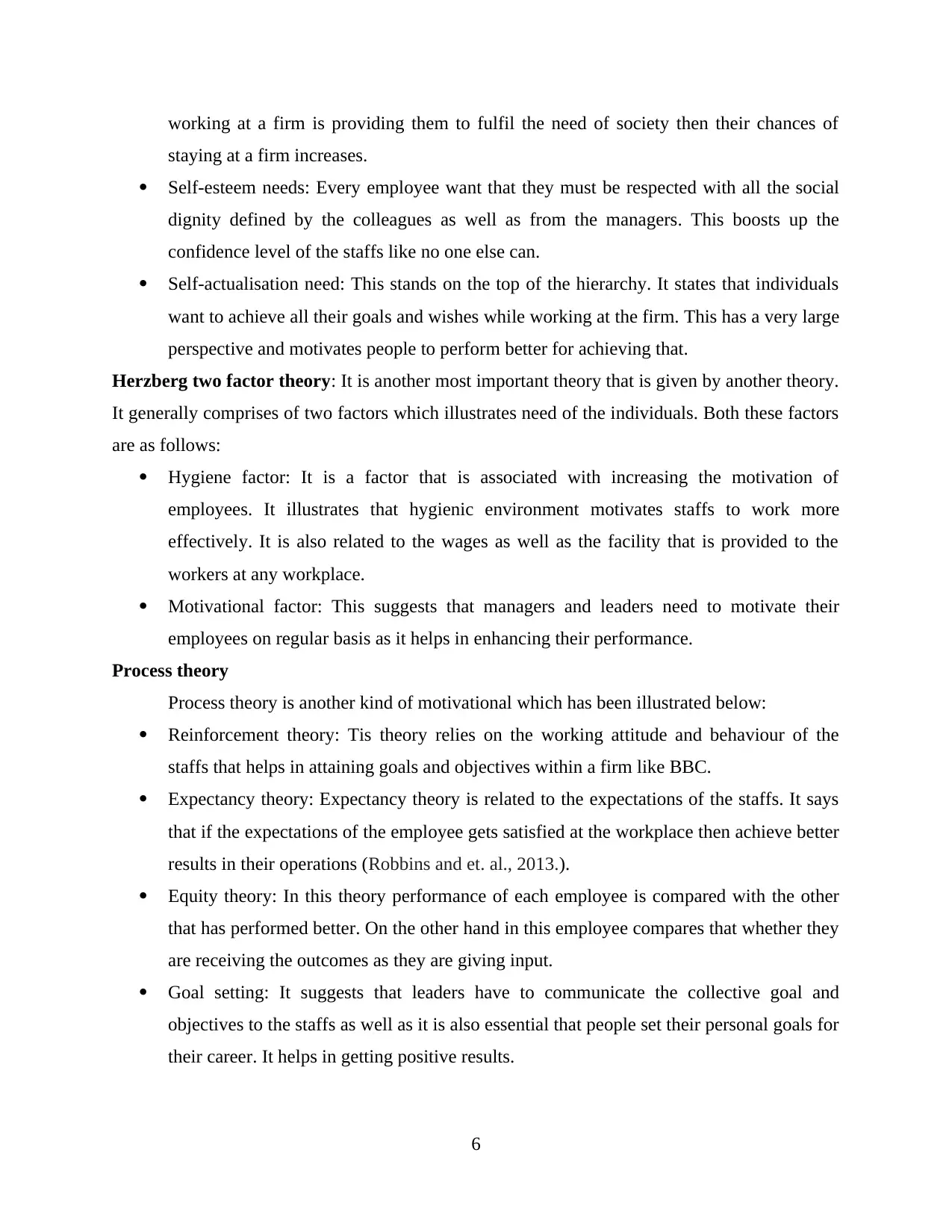
working at a firm is providing them to fulfil the need of society then their chances of
staying at a firm increases.
Self-esteem needs: Every employee want that they must be respected with all the social
dignity defined by the colleagues as well as from the managers. This boosts up the
confidence level of the staffs like no one else can.
Self-actualisation need: This stands on the top of the hierarchy. It states that individuals
want to achieve all their goals and wishes while working at the firm. This has a very large
perspective and motivates people to perform better for achieving that.
Herzberg two factor theory: It is another most important theory that is given by another theory.
It generally comprises of two factors which illustrates need of the individuals. Both these factors
are as follows:
Hygiene factor: It is a factor that is associated with increasing the motivation of
employees. It illustrates that hygienic environment motivates staffs to work more
effectively. It is also related to the wages as well as the facility that is provided to the
workers at any workplace.
Motivational factor: This suggests that managers and leaders need to motivate their
employees on regular basis as it helps in enhancing their performance.
Process theory
Process theory is another kind of motivational which has been illustrated below:
Reinforcement theory: Tis theory relies on the working attitude and behaviour of the
staffs that helps in attaining goals and objectives within a firm like BBC.
Expectancy theory: Expectancy theory is related to the expectations of the staffs. It says
that if the expectations of the employee gets satisfied at the workplace then achieve better
results in their operations (Robbins and et. al., 2013.).
Equity theory: In this theory performance of each employee is compared with the other
that has performed better. On the other hand in this employee compares that whether they
are receiving the outcomes as they are giving input.
Goal setting: It suggests that leaders have to communicate the collective goal and
objectives to the staffs as well as it is also essential that people set their personal goals for
their career. It helps in getting positive results.
6
staying at a firm increases.
Self-esteem needs: Every employee want that they must be respected with all the social
dignity defined by the colleagues as well as from the managers. This boosts up the
confidence level of the staffs like no one else can.
Self-actualisation need: This stands on the top of the hierarchy. It states that individuals
want to achieve all their goals and wishes while working at the firm. This has a very large
perspective and motivates people to perform better for achieving that.
Herzberg two factor theory: It is another most important theory that is given by another theory.
It generally comprises of two factors which illustrates need of the individuals. Both these factors
are as follows:
Hygiene factor: It is a factor that is associated with increasing the motivation of
employees. It illustrates that hygienic environment motivates staffs to work more
effectively. It is also related to the wages as well as the facility that is provided to the
workers at any workplace.
Motivational factor: This suggests that managers and leaders need to motivate their
employees on regular basis as it helps in enhancing their performance.
Process theory
Process theory is another kind of motivational which has been illustrated below:
Reinforcement theory: Tis theory relies on the working attitude and behaviour of the
staffs that helps in attaining goals and objectives within a firm like BBC.
Expectancy theory: Expectancy theory is related to the expectations of the staffs. It says
that if the expectations of the employee gets satisfied at the workplace then achieve better
results in their operations (Robbins and et. al., 2013.).
Equity theory: In this theory performance of each employee is compared with the other
that has performed better. On the other hand in this employee compares that whether they
are receiving the outcomes as they are giving input.
Goal setting: It suggests that leaders have to communicate the collective goal and
objectives to the staffs as well as it is also essential that people set their personal goals for
their career. It helps in getting positive results.
6
⊘ This is a preview!⊘
Do you want full access?
Subscribe today to unlock all pages.

Trusted by 1+ million students worldwide
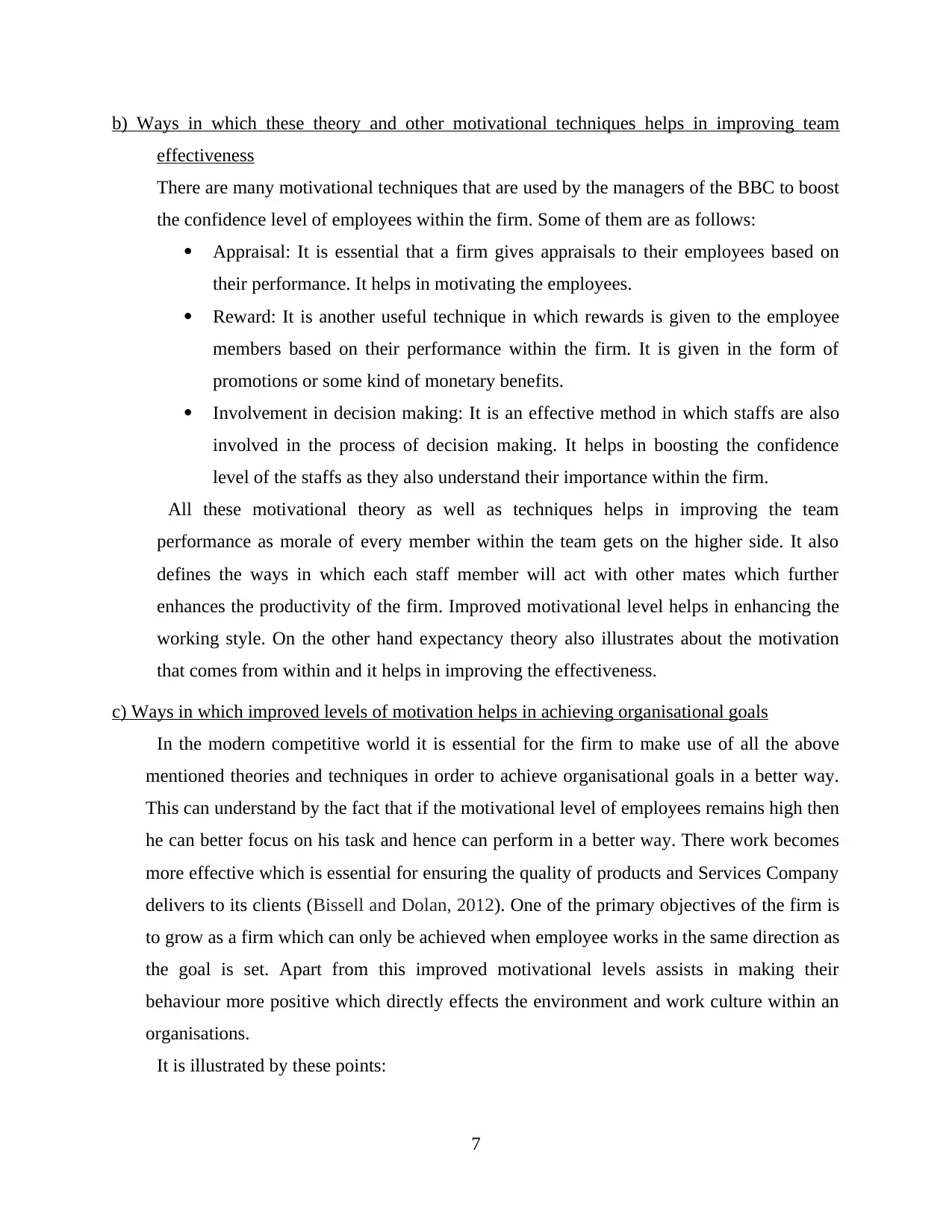
b) Ways in which these theory and other motivational techniques helps in improving team
effectiveness
There are many motivational techniques that are used by the managers of the BBC to boost
the confidence level of employees within the firm. Some of them are as follows:
Appraisal: It is essential that a firm gives appraisals to their employees based on
their performance. It helps in motivating the employees.
Reward: It is another useful technique in which rewards is given to the employee
members based on their performance within the firm. It is given in the form of
promotions or some kind of monetary benefits.
Involvement in decision making: It is an effective method in which staffs are also
involved in the process of decision making. It helps in boosting the confidence
level of the staffs as they also understand their importance within the firm.
All these motivational theory as well as techniques helps in improving the team
performance as morale of every member within the team gets on the higher side. It also
defines the ways in which each staff member will act with other mates which further
enhances the productivity of the firm. Improved motivational level helps in enhancing the
working style. On the other hand expectancy theory also illustrates about the motivation
that comes from within and it helps in improving the effectiveness.
c) Ways in which improved levels of motivation helps in achieving organisational goals
In the modern competitive world it is essential for the firm to make use of all the above
mentioned theories and techniques in order to achieve organisational goals in a better way.
This can understand by the fact that if the motivational level of employees remains high then
he can better focus on his task and hence can perform in a better way. There work becomes
more effective which is essential for ensuring the quality of products and Services Company
delivers to its clients (Bissell and Dolan, 2012). One of the primary objectives of the firm is
to grow as a firm which can only be achieved when employee works in the same direction as
the goal is set. Apart from this improved motivational levels assists in making their
behaviour more positive which directly effects the environment and work culture within an
organisations.
It is illustrated by these points:
7
effectiveness
There are many motivational techniques that are used by the managers of the BBC to boost
the confidence level of employees within the firm. Some of them are as follows:
Appraisal: It is essential that a firm gives appraisals to their employees based on
their performance. It helps in motivating the employees.
Reward: It is another useful technique in which rewards is given to the employee
members based on their performance within the firm. It is given in the form of
promotions or some kind of monetary benefits.
Involvement in decision making: It is an effective method in which staffs are also
involved in the process of decision making. It helps in boosting the confidence
level of the staffs as they also understand their importance within the firm.
All these motivational theory as well as techniques helps in improving the team
performance as morale of every member within the team gets on the higher side. It also
defines the ways in which each staff member will act with other mates which further
enhances the productivity of the firm. Improved motivational level helps in enhancing the
working style. On the other hand expectancy theory also illustrates about the motivation
that comes from within and it helps in improving the effectiveness.
c) Ways in which improved levels of motivation helps in achieving organisational goals
In the modern competitive world it is essential for the firm to make use of all the above
mentioned theories and techniques in order to achieve organisational goals in a better way.
This can understand by the fact that if the motivational level of employees remains high then
he can better focus on his task and hence can perform in a better way. There work becomes
more effective which is essential for ensuring the quality of products and Services Company
delivers to its clients (Bissell and Dolan, 2012). One of the primary objectives of the firm is
to grow as a firm which can only be achieved when employee works in the same direction as
the goal is set. Apart from this improved motivational levels assists in making their
behaviour more positive which directly effects the environment and work culture within an
organisations.
It is illustrated by these points:
7
Paraphrase This Document
Need a fresh take? Get an instant paraphrase of this document with our AI Paraphraser
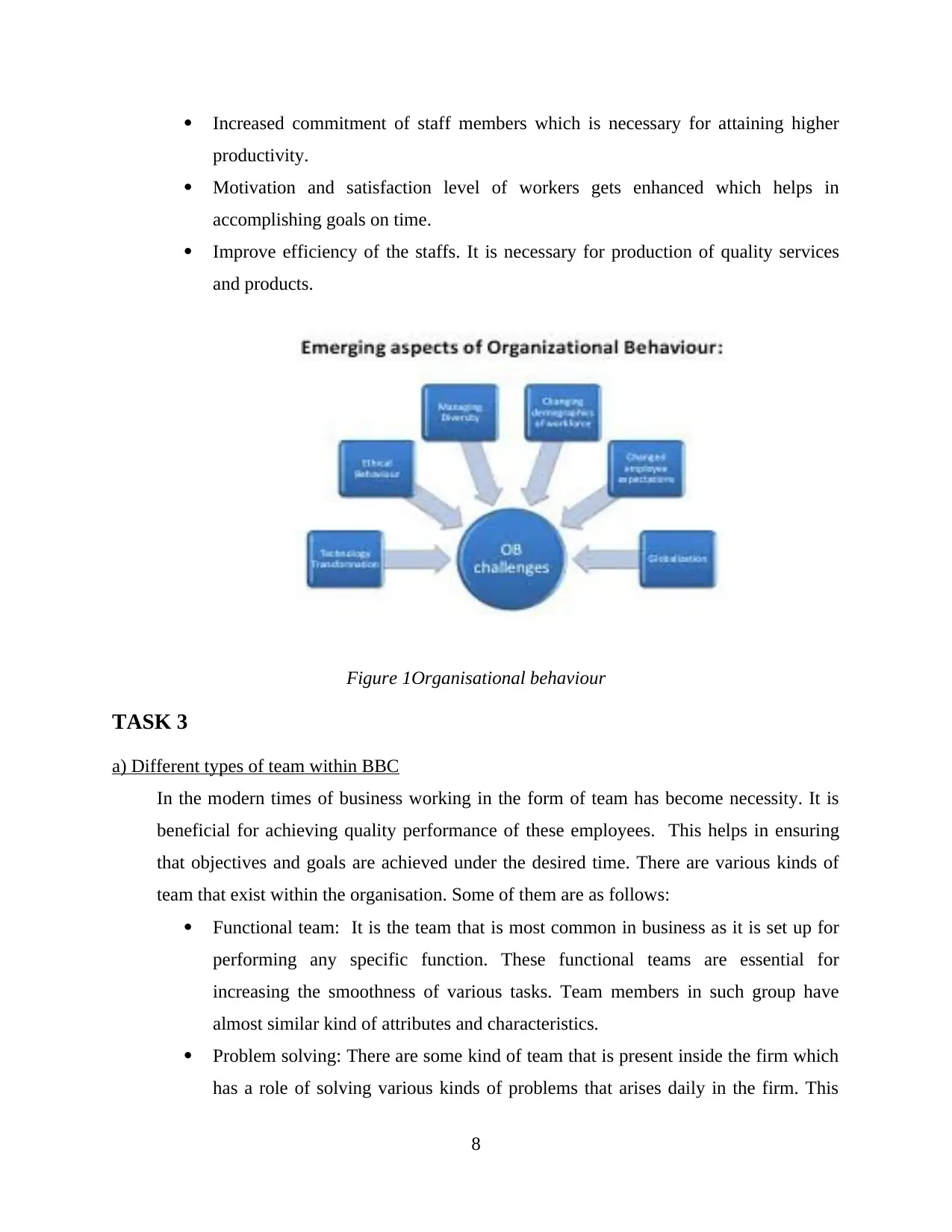
Increased commitment of staff members which is necessary for attaining higher
productivity.
Motivation and satisfaction level of workers gets enhanced which helps in
accomplishing goals on time.
Improve efficiency of the staffs. It is necessary for production of quality services
and products.
Figure 1Organisational behaviour
TASK 3
a) Different types of team within BBC
In the modern times of business working in the form of team has become necessity. It is
beneficial for achieving quality performance of these employees. This helps in ensuring
that objectives and goals are achieved under the desired time. There are various kinds of
team that exist within the organisation. Some of them are as follows:
Functional team: It is the team that is most common in business as it is set up for
performing any specific function. These functional teams are essential for
increasing the smoothness of various tasks. Team members in such group have
almost similar kind of attributes and characteristics.
Problem solving: There are some kind of team that is present inside the firm which
has a role of solving various kinds of problems that arises daily in the firm. This
8
productivity.
Motivation and satisfaction level of workers gets enhanced which helps in
accomplishing goals on time.
Improve efficiency of the staffs. It is necessary for production of quality services
and products.
Figure 1Organisational behaviour
TASK 3
a) Different types of team within BBC
In the modern times of business working in the form of team has become necessity. It is
beneficial for achieving quality performance of these employees. This helps in ensuring
that objectives and goals are achieved under the desired time. There are various kinds of
team that exist within the organisation. Some of them are as follows:
Functional team: It is the team that is most common in business as it is set up for
performing any specific function. These functional teams are essential for
increasing the smoothness of various tasks. Team members in such group have
almost similar kind of attributes and characteristics.
Problem solving: There are some kind of team that is present inside the firm which
has a role of solving various kinds of problems that arises daily in the firm. This
8
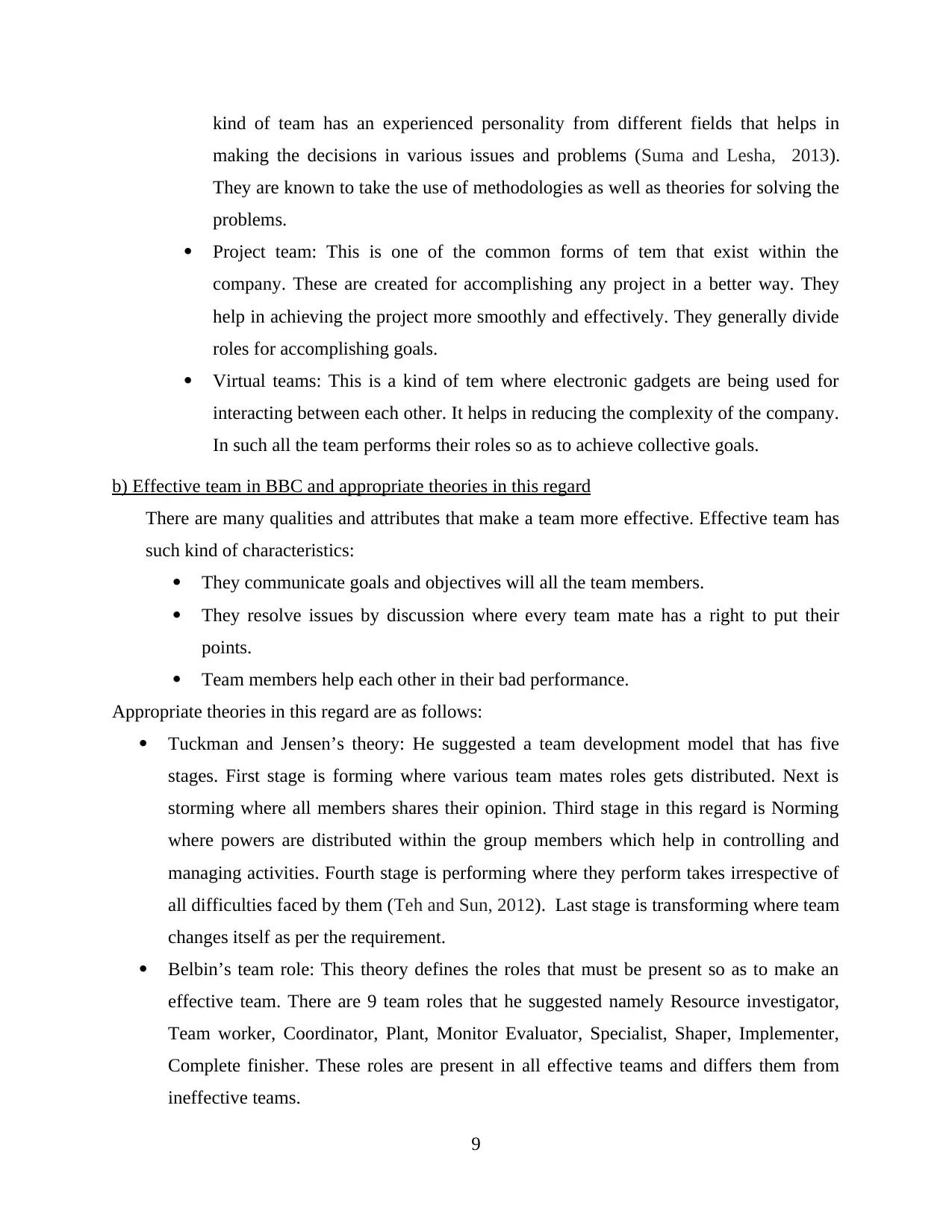
kind of team has an experienced personality from different fields that helps in
making the decisions in various issues and problems (Suma and Lesha, 2013).
They are known to take the use of methodologies as well as theories for solving the
problems.
Project team: This is one of the common forms of tem that exist within the
company. These are created for accomplishing any project in a better way. They
help in achieving the project more smoothly and effectively. They generally divide
roles for accomplishing goals.
Virtual teams: This is a kind of tem where electronic gadgets are being used for
interacting between each other. It helps in reducing the complexity of the company.
In such all the team performs their roles so as to achieve collective goals.
b) Effective team in BBC and appropriate theories in this regard
There are many qualities and attributes that make a team more effective. Effective team has
such kind of characteristics:
They communicate goals and objectives will all the team members.
They resolve issues by discussion where every team mate has a right to put their
points.
Team members help each other in their bad performance.
Appropriate theories in this regard are as follows:
Tuckman and Jensen’s theory: He suggested a team development model that has five
stages. First stage is forming where various team mates roles gets distributed. Next is
storming where all members shares their opinion. Third stage in this regard is Norming
where powers are distributed within the group members which help in controlling and
managing activities. Fourth stage is performing where they perform takes irrespective of
all difficulties faced by them (Teh and Sun, 2012). Last stage is transforming where team
changes itself as per the requirement.
Belbin’s team role: This theory defines the roles that must be present so as to make an
effective team. There are 9 team roles that he suggested namely Resource investigator,
Team worker, Coordinator, Plant, Monitor Evaluator, Specialist, Shaper, Implementer,
Complete finisher. These roles are present in all effective teams and differs them from
ineffective teams.
9
making the decisions in various issues and problems (Suma and Lesha, 2013).
They are known to take the use of methodologies as well as theories for solving the
problems.
Project team: This is one of the common forms of tem that exist within the
company. These are created for accomplishing any project in a better way. They
help in achieving the project more smoothly and effectively. They generally divide
roles for accomplishing goals.
Virtual teams: This is a kind of tem where electronic gadgets are being used for
interacting between each other. It helps in reducing the complexity of the company.
In such all the team performs their roles so as to achieve collective goals.
b) Effective team in BBC and appropriate theories in this regard
There are many qualities and attributes that make a team more effective. Effective team has
such kind of characteristics:
They communicate goals and objectives will all the team members.
They resolve issues by discussion where every team mate has a right to put their
points.
Team members help each other in their bad performance.
Appropriate theories in this regard are as follows:
Tuckman and Jensen’s theory: He suggested a team development model that has five
stages. First stage is forming where various team mates roles gets distributed. Next is
storming where all members shares their opinion. Third stage in this regard is Norming
where powers are distributed within the group members which help in controlling and
managing activities. Fourth stage is performing where they perform takes irrespective of
all difficulties faced by them (Teh and Sun, 2012). Last stage is transforming where team
changes itself as per the requirement.
Belbin’s team role: This theory defines the roles that must be present so as to make an
effective team. There are 9 team roles that he suggested namely Resource investigator,
Team worker, Coordinator, Plant, Monitor Evaluator, Specialist, Shaper, Implementer,
Complete finisher. These roles are present in all effective teams and differs them from
ineffective teams.
9
⊘ This is a preview!⊘
Do you want full access?
Subscribe today to unlock all pages.

Trusted by 1+ million students worldwide
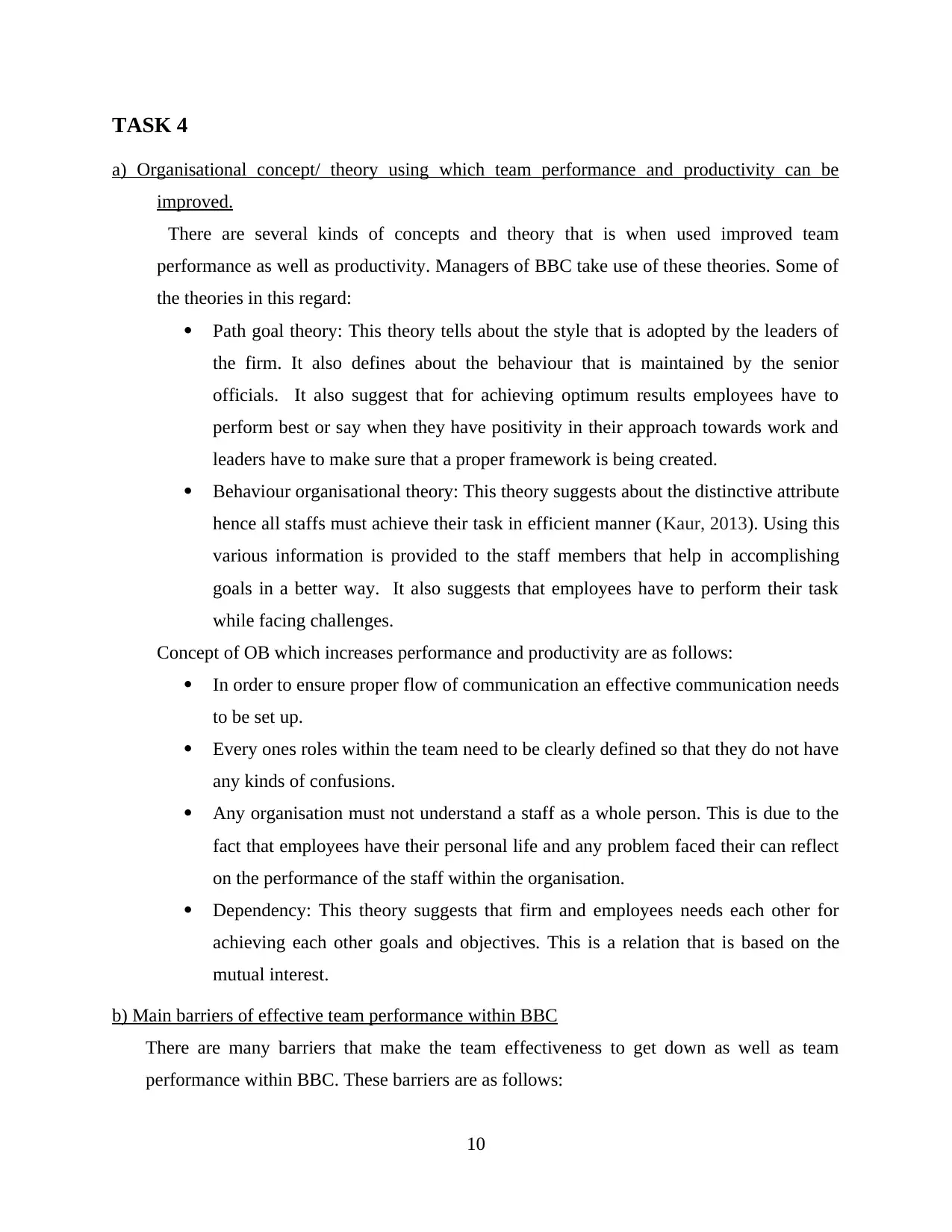
TASK 4
a) Organisational concept/ theory using which team performance and productivity can be
improved.
There are several kinds of concepts and theory that is when used improved team
performance as well as productivity. Managers of BBC take use of these theories. Some of
the theories in this regard:
Path goal theory: This theory tells about the style that is adopted by the leaders of
the firm. It also defines about the behaviour that is maintained by the senior
officials. It also suggest that for achieving optimum results employees have to
perform best or say when they have positivity in their approach towards work and
leaders have to make sure that a proper framework is being created.
Behaviour organisational theory: This theory suggests about the distinctive attribute
hence all staffs must achieve their task in efficient manner (Kaur, 2013). Using this
various information is provided to the staff members that help in accomplishing
goals in a better way. It also suggests that employees have to perform their task
while facing challenges.
Concept of OB which increases performance and productivity are as follows:
In order to ensure proper flow of communication an effective communication needs
to be set up.
Every ones roles within the team need to be clearly defined so that they do not have
any kinds of confusions.
Any organisation must not understand a staff as a whole person. This is due to the
fact that employees have their personal life and any problem faced their can reflect
on the performance of the staff within the organisation.
Dependency: This theory suggests that firm and employees needs each other for
achieving each other goals and objectives. This is a relation that is based on the
mutual interest.
b) Main barriers of effective team performance within BBC
There are many barriers that make the team effectiveness to get down as well as team
performance within BBC. These barriers are as follows:
10
a) Organisational concept/ theory using which team performance and productivity can be
improved.
There are several kinds of concepts and theory that is when used improved team
performance as well as productivity. Managers of BBC take use of these theories. Some of
the theories in this regard:
Path goal theory: This theory tells about the style that is adopted by the leaders of
the firm. It also defines about the behaviour that is maintained by the senior
officials. It also suggest that for achieving optimum results employees have to
perform best or say when they have positivity in their approach towards work and
leaders have to make sure that a proper framework is being created.
Behaviour organisational theory: This theory suggests about the distinctive attribute
hence all staffs must achieve their task in efficient manner (Kaur, 2013). Using this
various information is provided to the staff members that help in accomplishing
goals in a better way. It also suggests that employees have to perform their task
while facing challenges.
Concept of OB which increases performance and productivity are as follows:
In order to ensure proper flow of communication an effective communication needs
to be set up.
Every ones roles within the team need to be clearly defined so that they do not have
any kinds of confusions.
Any organisation must not understand a staff as a whole person. This is due to the
fact that employees have their personal life and any problem faced their can reflect
on the performance of the staff within the organisation.
Dependency: This theory suggests that firm and employees needs each other for
achieving each other goals and objectives. This is a relation that is based on the
mutual interest.
b) Main barriers of effective team performance within BBC
There are many barriers that make the team effectiveness to get down as well as team
performance within BBC. These barriers are as follows:
10
Paraphrase This Document
Need a fresh take? Get an instant paraphrase of this document with our AI Paraphraser
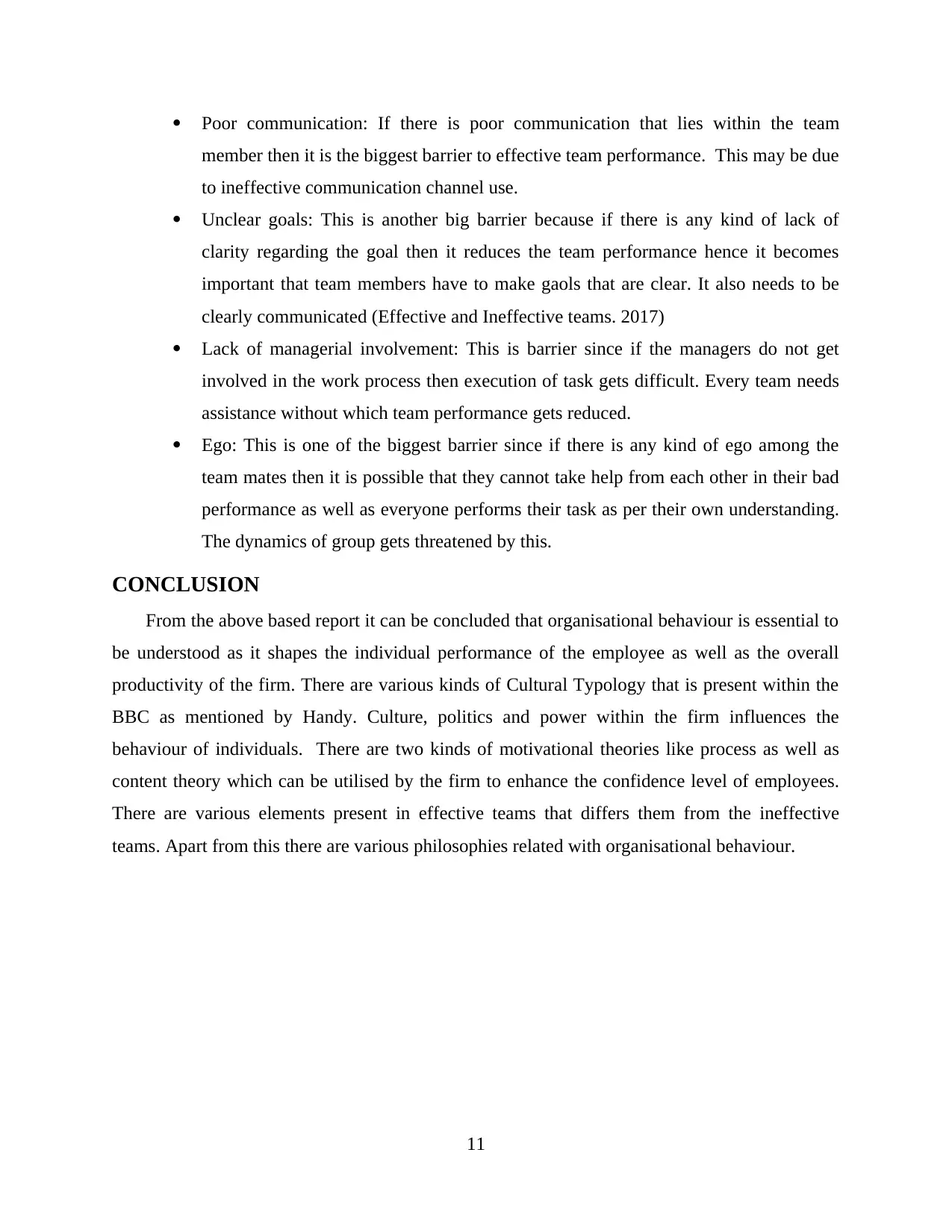
Poor communication: If there is poor communication that lies within the team
member then it is the biggest barrier to effective team performance. This may be due
to ineffective communication channel use.
Unclear goals: This is another big barrier because if there is any kind of lack of
clarity regarding the goal then it reduces the team performance hence it becomes
important that team members have to make gaols that are clear. It also needs to be
clearly communicated (Effective and Ineffective teams. 2017)
Lack of managerial involvement: This is barrier since if the managers do not get
involved in the work process then execution of task gets difficult. Every team needs
assistance without which team performance gets reduced.
Ego: This is one of the biggest barrier since if there is any kind of ego among the
team mates then it is possible that they cannot take help from each other in their bad
performance as well as everyone performs their task as per their own understanding.
The dynamics of group gets threatened by this.
CONCLUSION
From the above based report it can be concluded that organisational behaviour is essential to
be understood as it shapes the individual performance of the employee as well as the overall
productivity of the firm. There are various kinds of Cultural Typology that is present within the
BBC as mentioned by Handy. Culture, politics and power within the firm influences the
behaviour of individuals. There are two kinds of motivational theories like process as well as
content theory which can be utilised by the firm to enhance the confidence level of employees.
There are various elements present in effective teams that differs them from the ineffective
teams. Apart from this there are various philosophies related with organisational behaviour.
11
member then it is the biggest barrier to effective team performance. This may be due
to ineffective communication channel use.
Unclear goals: This is another big barrier because if there is any kind of lack of
clarity regarding the goal then it reduces the team performance hence it becomes
important that team members have to make gaols that are clear. It also needs to be
clearly communicated (Effective and Ineffective teams. 2017)
Lack of managerial involvement: This is barrier since if the managers do not get
involved in the work process then execution of task gets difficult. Every team needs
assistance without which team performance gets reduced.
Ego: This is one of the biggest barrier since if there is any kind of ego among the
team mates then it is possible that they cannot take help from each other in their bad
performance as well as everyone performs their task as per their own understanding.
The dynamics of group gets threatened by this.
CONCLUSION
From the above based report it can be concluded that organisational behaviour is essential to
be understood as it shapes the individual performance of the employee as well as the overall
productivity of the firm. There are various kinds of Cultural Typology that is present within the
BBC as mentioned by Handy. Culture, politics and power within the firm influences the
behaviour of individuals. There are two kinds of motivational theories like process as well as
content theory which can be utilised by the firm to enhance the confidence level of employees.
There are various elements present in effective teams that differs them from the ineffective
teams. Apart from this there are various philosophies related with organisational behaviour.
11
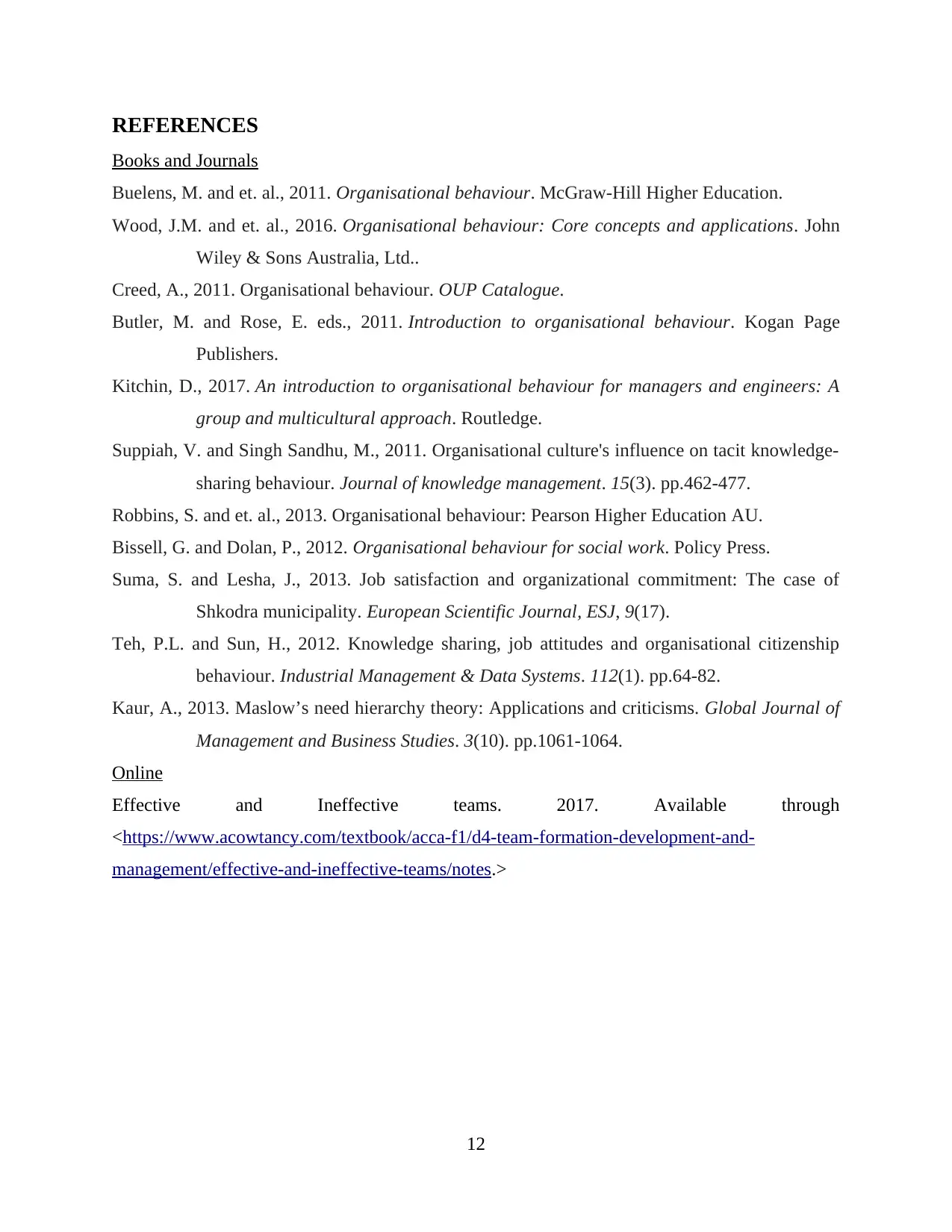
REFERENCES
Books and Journals
Buelens, M. and et. al., 2011. Organisational behaviour. McGraw-Hill Higher Education.
Wood, J.M. and et. al., 2016. Organisational behaviour: Core concepts and applications. John
Wiley & Sons Australia, Ltd..
Creed, A., 2011. Organisational behaviour. OUP Catalogue.
Butler, M. and Rose, E. eds., 2011. Introduction to organisational behaviour. Kogan Page
Publishers.
Kitchin, D., 2017. An introduction to organisational behaviour for managers and engineers: A
group and multicultural approach. Routledge.
Suppiah, V. and Singh Sandhu, M., 2011. Organisational culture's influence on tacit knowledge-
sharing behaviour. Journal of knowledge management. 15(3). pp.462-477.
Robbins, S. and et. al., 2013. Organisational behaviour: Pearson Higher Education AU.
Bissell, G. and Dolan, P., 2012. Organisational behaviour for social work. Policy Press.
Suma, S. and Lesha, J., 2013. Job satisfaction and organizational commitment: The case of
Shkodra municipality. European Scientific Journal, ESJ, 9(17).
Teh, P.L. and Sun, H., 2012. Knowledge sharing, job attitudes and organisational citizenship
behaviour. Industrial Management & Data Systems. 112(1). pp.64-82.
Kaur, A., 2013. Maslow’s need hierarchy theory: Applications and criticisms. Global Journal of
Management and Business Studies. 3(10). pp.1061-1064.
Online
Effective and Ineffective teams. 2017. Available through
<https://www.acowtancy.com/textbook/acca-f1/d4-team-formation-development-and-
management/effective-and-ineffective-teams/notes.>
12
Books and Journals
Buelens, M. and et. al., 2011. Organisational behaviour. McGraw-Hill Higher Education.
Wood, J.M. and et. al., 2016. Organisational behaviour: Core concepts and applications. John
Wiley & Sons Australia, Ltd..
Creed, A., 2011. Organisational behaviour. OUP Catalogue.
Butler, M. and Rose, E. eds., 2011. Introduction to organisational behaviour. Kogan Page
Publishers.
Kitchin, D., 2017. An introduction to organisational behaviour for managers and engineers: A
group and multicultural approach. Routledge.
Suppiah, V. and Singh Sandhu, M., 2011. Organisational culture's influence on tacit knowledge-
sharing behaviour. Journal of knowledge management. 15(3). pp.462-477.
Robbins, S. and et. al., 2013. Organisational behaviour: Pearson Higher Education AU.
Bissell, G. and Dolan, P., 2012. Organisational behaviour for social work. Policy Press.
Suma, S. and Lesha, J., 2013. Job satisfaction and organizational commitment: The case of
Shkodra municipality. European Scientific Journal, ESJ, 9(17).
Teh, P.L. and Sun, H., 2012. Knowledge sharing, job attitudes and organisational citizenship
behaviour. Industrial Management & Data Systems. 112(1). pp.64-82.
Kaur, A., 2013. Maslow’s need hierarchy theory: Applications and criticisms. Global Journal of
Management and Business Studies. 3(10). pp.1061-1064.
Online
Effective and Ineffective teams. 2017. Available through
<https://www.acowtancy.com/textbook/acca-f1/d4-team-formation-development-and-
management/effective-and-ineffective-teams/notes.>
12
⊘ This is a preview!⊘
Do you want full access?
Subscribe today to unlock all pages.

Trusted by 1+ million students worldwide
1 out of 12
Related Documents
Your All-in-One AI-Powered Toolkit for Academic Success.
+13062052269
info@desklib.com
Available 24*7 on WhatsApp / Email
![[object Object]](/_next/static/media/star-bottom.7253800d.svg)
Unlock your academic potential
Copyright © 2020–2025 A2Z Services. All Rights Reserved. Developed and managed by ZUCOL.





